Fluidised bed processing – Added-value ingredients for better products
The properties of functional ingredients can be fine-tuned using fluidised bed spray granulation, agglomeration, microencapsulation and coating. At Health ingredients Europe, plant manufacturer Glatt Ingenieurtechnik will showcase a new compact spray agglomeration concept for industrial-scale continuous production.
» Author: Dr. Michael Jacob, Head of Process Technology Food, Feed & Fine Chemicals, Glatt Ingenieurtechnik GmbH
» originally published in the trade magazine ‘Nutraceuticals Now’, issue 11/2018, Johnson-Johnsen Publishing
The market for functional ingredients is growing rapidly. New products are constantly being supplemented with vitamins, minerals and other health-promoting ingredients, and are attracting a great deal of interest from increasingly health-oriented consumers. However, the manufacturing processes associated with these products present numerous challenges. That’s because gentle treatment throughout the entire process chain is essential in order for these valuable ingredients to achieve the desired effect when they enter the intestinal tract.
The form in which health-promoting probiotics, dietary fibres or antioxidants are consumed depends on both the preferences and everyday habits of consumers: some prefer sports drinks, protein bars or enriched iced tea, whereas others favour more direct dosage forms, such as effervescent tablets, sachets or capsules. A universal requirement, though, is that functional ingredients must be stable during storage, precisely dosed and dissolve quickly, or have a depot effect; they must neither lump nor separate. Key factors are excellent flow properties, the absence of dust and a precisely adjustable bulk density. Fluidised bed processing is ideally suited to the large-scale production of these ingredients. In many branches of the industry, fluidised bed technology is used to agglomerate powders, dry liquid ingredients into granulates or pellets, encapsulate them in microcapsules and, if required, encase them in a functional coating.
Fluidised bed principle
Fluid bed technology is an efficient process option to transfer liquid raw materials directly into free-flowing, compact and dust-free granules (spray granulation or micro-encapsulationMicro-encapsulation) or powdery raw materials to homogeneous easy to redisperse (instant) products (spray agglomeration) in a single process step batch-wise or continuous, single- or multi-stage. For example, fluidised bed spray agglomeration involves spraying a liquid into a fluidised bed, forming liquid bridges between the colliding particles. The liquid bridges are dried and solidified, and so the fine powder is transformed into coarser agglomerates with a larger grain structure and improved application properties. The stable bonds reduce risk of breakage and abrasion during the handling, processing and storage; plus, the final product is dust-free, free flowing and can be precisely metered. The porous structure of the agglomerates determines their improved wetting and solubility behaviour, which defines the ease of use and, ultimately, commercial success of a product.
Binding agents
The applications described above can usually be agglomerated using water as the binding agent. The spray liquid is directed into the fluidised bed from above or below, and generates sufficient liquid bridges by moistening and partly dissolving the surface of powder. The advantage of using water as a spray medium is that no binding agents have to be mixed, stored or added, and the cleaning of the spraying system is easier with regard to product changeover and hygiene. In some cases, agglomerates are not stable enough; this can be remedied by adding carbohydrates, for example, to the spray liquid. And if stickiness needs to be increased for higher agglomeration rates, the spray temperature or spray pressure can be lowered. If harder, more stable particles are required – as a prerequisite for further processing, for example – this can be controlled by binder substance viscosity, process time and temperature profile.
By selecting the appropriate spray medium (composition, viscosity, temperature and concentration), a variety of effects can be achieved. Spray fluids with high viscosities improve the internal structure of instant products and ensure they disperse more easily. In principle, organic substances can also be spray agglomerated, to improve the consistency of sauces or the rehydration capability of starch, for example. Raw materials with oily components such as chocolate powder require an emulsifier for better dispersion. Inorganic substances can be used to agglomerate components and mixtures for fine chemicals.
Spray agglomerated proteins and sweeteners
Fluidised bed spray agglomeration is an important process for substances intended for solid dosage applications, such as vitamin formulations and dried probiotics. Like minerals and micronutrients, their particle structure, moisture and bulk density must be adjusted according to application. When filling into cans, capsules or sachets or compressing into effervescent tablets where high accuracy is required, reproducible product properties like blend uniformity, flowability and particle size have to be ensured. Sports drinks often require the protein powder to have a low bulk density and a high porosity. High wettability ensures that the particles disperse or dissolve rapidly without residue when mixed in water, milk or plant-based drinks. This also applies to sugar substitutes such as polyols, including xylitol, maltitol or lactitol, for the production of calorie- and sugar-free foods and drinks. Components for premixes and raw materials with added value can also be prepared for industrial production processes using spray agglomeration. For a wide range of quantities, the plant manufacturer Glatt Ingenieurtechnik has developed a new compact system that makes continuous production both economical and safe (view box text).
Vitamin enrichment via spray granulation and micro-encapsulation
The enrichment of nutritional and functional foods with active substances like vitamin C or A makes it necessary to stabilise the sensitive ingredients and protect them from oxygen, light, moisture and heat – such as during further production of the final product or for its shelf life. Enclosed in compact microcapsules made of starch derivates, celluloses or maltodextrins, the stabilised formulation can then be stored for further processing. In the fluidised bed, the heat-sensitive vitamins are enclosed in matrices at low temperatures without losing any of their functional or nutritional properties. The process is also suitable for sensitive ingredients such as essential oils, omega-3 fatty acids, enzymes and micro-organisms that require a homogenous distribution profile, as well as for odour or taste-masking. Incompatible substances can be protected against unwanted reactions by using a dense coating.
Additives and coating
In addition to technical issues, encapsulation challenges can also be overcome by modifying the formulation, such as by using stabilising additives and/or applying a protective coating. The selection of suitable particle structure and beneficial functional additives is determined by the release mechanism and the active substance itself. Fluidised bed spray coating is the method of choice when the optimisation of product properties involves, for example, controlled release mechanisms, modifying the surface structure for higher thermal and oxidation stability, and also masking odours or flavours.
Starting small
Whether large-scale production or compact plant, every product idea starts small. It is generally recommended to start by carrying out tests on a laboratory plant with lower quantities of raw materials. With the help of in-process analyses of the active substance or other important particle characteristics — such as size and bulk density — procedures can be quickly adapted to obtain the desired product properties. Glatt provides test facilities with various process operations, system configurations and laboratory equipment at its Technology Center in Weimar, Germany. A team of experienced food and process engineering experts is available throughout the product and process development phase. For reliable scale-up to production scale, local pilot plants are also available for both continuous and batch processing.
[Box text] Compact system solution for continuous agglomeration
Continuously operating fluidised bed systems offer considerable benefits during large-scale production, saving time and money, and enabling process parameters to be fine-tuned. To capitalise on the benefits of consistent, reproducible quality, even for smaller product runs, Glatt Ingenieurtechnik has developed a compact system for classic agglomeration applications in the food and fine chemicals industries that covers performance ranges from 100kg to 3 tons per hour in various sizes. Like their standard GF granulators, this space-saving equipment is designed for continuous multi-step and multi-zone processes, and thus offers virtually unlimited flexibility. The Glatt GF ModFlex system solution has a modular design and was specifically developed for continuous powder agglomeration applications in limited-height rooms. With low operating costs and an installation time of just 12 days, the concept meets all requirements for the hygienic, safe and cost-effective continuous agglomeration of powder components. A demand-oriented space concept is also supplied. The modules are preinstalled and preassembled to save the customer both time and money. Thanks to the optimised system, operating costs are reduced by another 5-10 per cent. For example, the ModFlex GF 350 model produces 200–300 kg/h, whereas the GF 750 model produces 2–3 tons per hour. The “GlattView Varia” control system is included. Glatt Ingenieurtechnik also offers solutions for completely different production quantities that can be adapted to individual customer requirements. Technically, the compact units offer the same as the large Glatt systems: four process chambers, an integrated WIP system, ATEX compliance, the plate filter concept, etc. For further information, visit Glatt Ingenieurtechnik at HiE in Frankfurt, Germany: hall 8, booth P130.
Further information on this topic and related topics can also be found in the following publications:
Published article: ‘The gentle processing of highly volatile oils by fluid bed and spouted bed technology’ PDF, English
Published article: ‘Contract manufacturing by fluid bed and spouted bed technology: Which is better, continuous or batch process?’ PDF, English
Published article: ‚Forward-looking plant planning – How pre-engineering can bring ideas to market faster‘ PDF, English
Published article: ‘Technologies à lit fluidisé / Fluid bed and spouted bed technology’ PDF, English/French
Published article: ‘Spray (micro)encapsulation of sensitive substances in matrix form – An overview of essential oil and vitamin case studies’ PDF, English


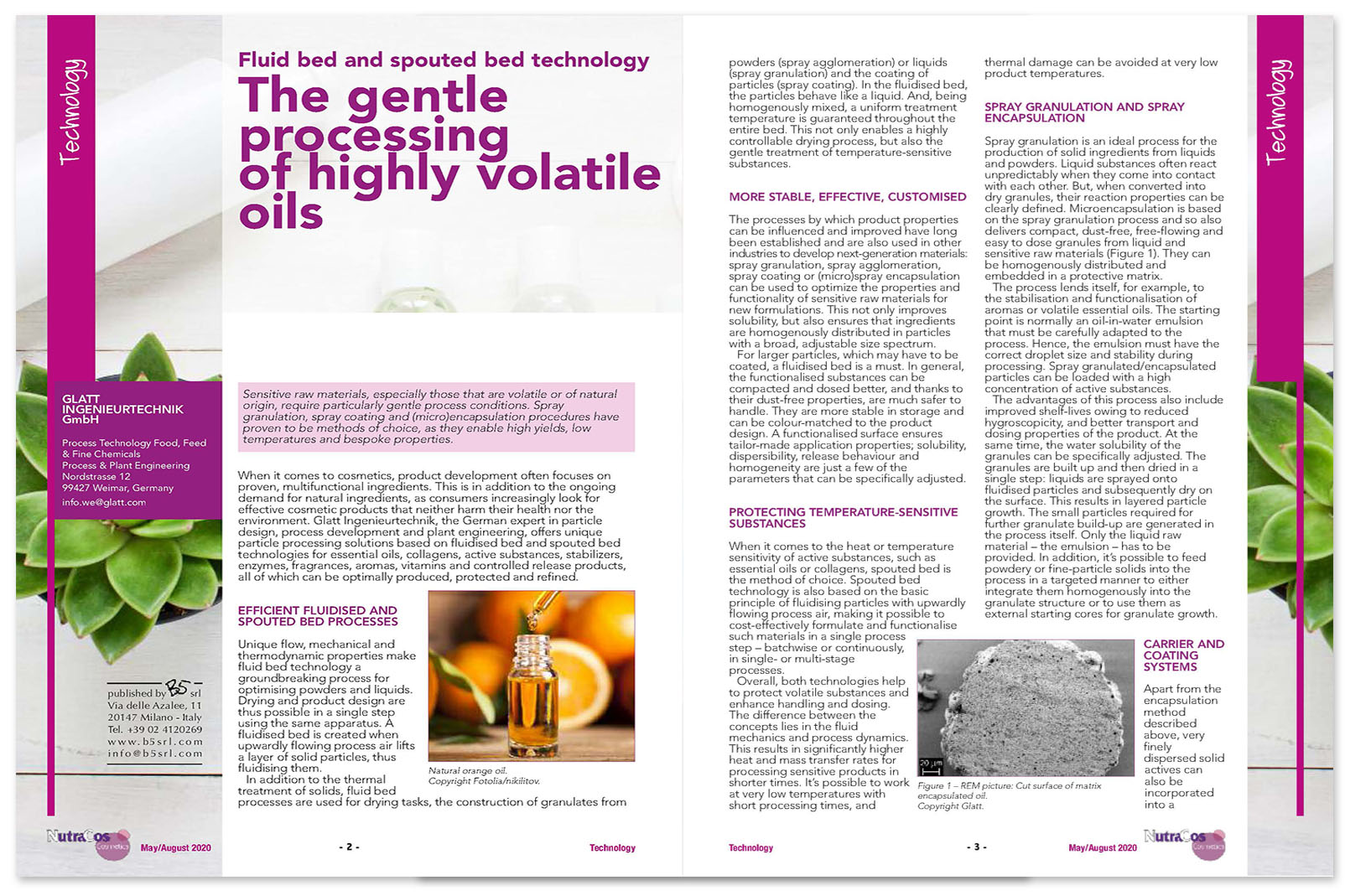
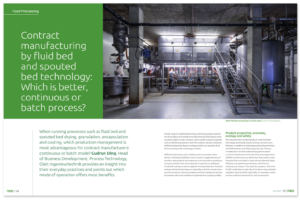
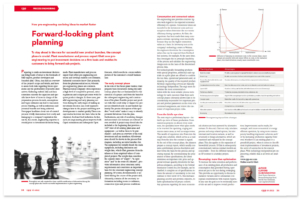
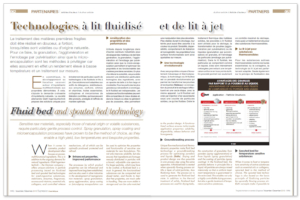
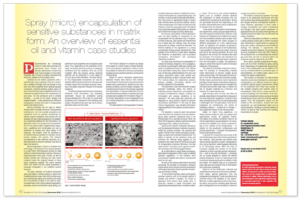
 Copyright: Vincentz Network GmbH & Co. KG
Copyright: Vincentz Network GmbH & Co. KG Copyright: Konradin-Verlag Robert Kohlhammer GmbH
Copyright: Konradin-Verlag Robert Kohlhammer GmbH